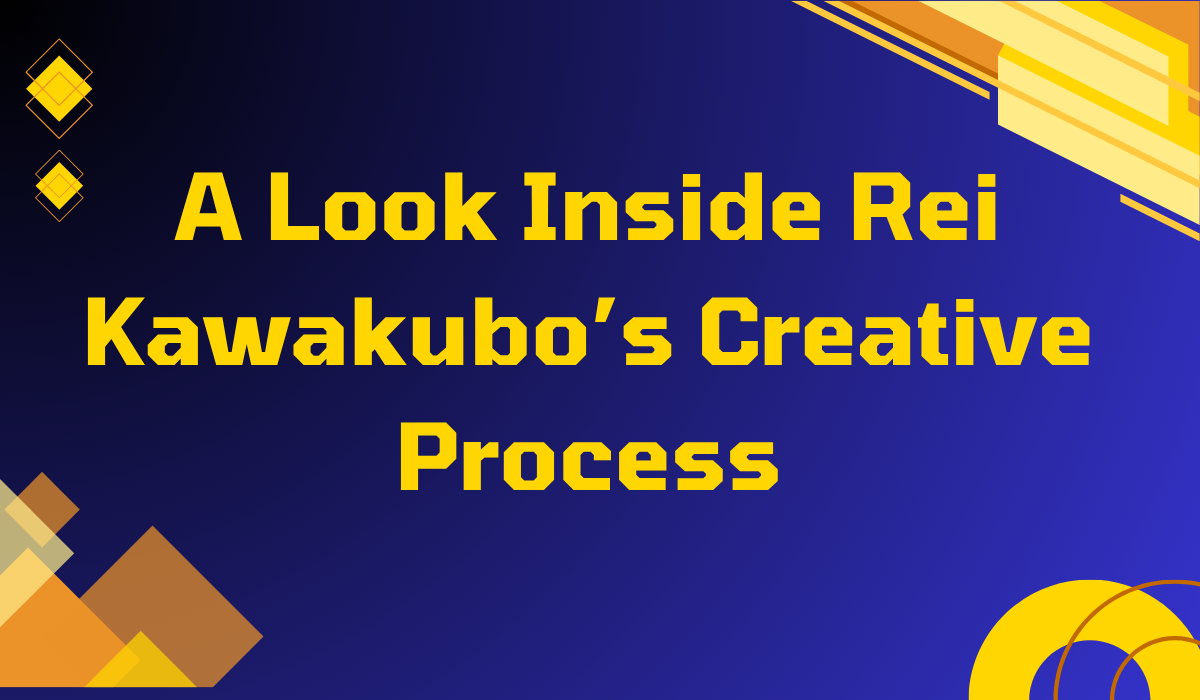Rei Kawakubo is not just a designer—she’s a disruptor, a philosopher, and a visionary who uses fashion as a medium to question, provoke, and reimagine the world. As the founder of Comme des Garçons, Kawakubo has spent decades rejecting conventional ideas of beauty, wearability, and form. Her collections don’t follow trends—they follow concepts, emotions, contradictions. To understand Rei Kawakubo’s creative process is to step into a world where logic dissolves and raw expression takes over.
This essay takes a close look inside Kawakubo’s famously secretive and unconventional creative process—how she thinks, how she creates, and why her approach has permanently changed fashion.
1. She Begins With a Concept, Not a Sketch
While most designers start with fabric swatches, mood boards, or silhouettes, Rei Kawakubo starts with an abstract idea. Her collections are driven by themes like “absence of clothes,” “in-betweeness,” “broken tailoring,” or “not making clothes.”
These aren’t marketing slogans—they’re the entire foundation of the work. Kawakubo often sets a philosophical or emotional goal and then builds her designs in opposition to or in conversation with it.
She once told Interview Magazine, “I want to make clothes that are new. I don’t feel like making anything that has been seen before. It’s not worth it.”
That means her process often starts not with “What will this look like?” but with “What hasn’t been done?” or “What can I destroy?”
2. Embracing the “Not Beautiful”
One of the defining pillars of Kawakubo’s process is her refusal to chase beauty. Instead, she embraces the “not beautiful”—the awkward, the imperfect, the misshapen. She is interested in tension, imbalance, and imperfection because they reflect the real world more honestly than polished surfaces ever could.
This is why so many of her garments are asymmetrical, unfinished, or constructed to make the wearer look strange or abstract. In Rei’s world, distortion is a design principle.
Her 1997 “Body Meets Dress, Dress Meets Body” collection, for instance, used internal padding to create bulbous, grotesque silhouettes that shocked audiences. The goal wasn’t to flatter—it was to challenge what fashion is allowed to do.
3. No Rules, Just Instinct
Kawakubo rarely follows traditional fashion structures—seasonal trends, gender norms, even commercial expectations. In many cases, she doesn’t even follow her own rules. Each season, she reinvents the process.
She doesn’t keep a team of sketchers or sit in long design meetings. Instead, she works in an intuitive, often solitary manner, handing rough ideas to her patternmakers and then reshaping them repeatedly. The patterns evolve not on paper, but through trial and error—cutting, draping, stitching, and destroying until something “new” appears.
In interviews, collaborators often describe her as intense, quiet, and demanding—but not because she wants perfection. It’s because she’s chasing something undefinable. Something that feels right, even if it doesn’t make sense.
4. Clothing as Sculpture
Many of Kawakubo’s collections are more akin to art installations or performance pieces than wearable fashion. This is intentional. Her creative process treats garments as three-dimensional objects, not just fabric for the body.
She frequently builds exaggerated silhouettes that distort the human form. This sculptural approach is rooted in her background—Kawakubo studied fine art and literature, not fashion design. That outsider perspective allows her to treat fashion as an artistic language, not a commercial product.
At times, her work is so sculptural it’s almost anti-functional. But that’s the point: Kawakubo isn’t dressing the body. She’s exploring what clothes can be when freed from function.
5. Subtraction, Not Addition
Unlike many designers who layer on embellishments and details, Kawakubo often works through subtraction and reduction. She strips ideas down until only the core remains—then builds around that void.
Her 2014 collection, for example, explored the idea of “the future of the silhouette” by removing any conventional body shape from the garments entirely. The pieces looked like abstract paper sculptures with holes for the arms and head. There was no waistline, no bust, no traditional fit. It was about erasing identity to find new form.
This subtractive thinking runs through much of her work: removing beauty, structure, logic—and seeing what’s left.
6. Collaboration Without Compromise
While Kawakubo is famously private and rarely gives interviews, she’s also deeply collaborative—particularly with patternmakers, stylists, artists, and her longtime partner Adrian Joffe. But her process isn’t about consensus.
Everyone involved in a CDG collection understands that Rei is the final voice. Patternmakers may spend days interpreting a vague instruction, only for Kawakubo to reject it with a single glance. It’s not about ego—it’s about vision. Her collaborators describe her process as one where you follow intuition into uncharted territory, with no map but Rei’s instinct.
7. Controlled Chaos
There is a myth that Kawakubo’s work is random or impulsive. In reality, her chaos is highly controlled. Her most wild collections—those featuring exploded forms, radical layering, or heavy distortion—are all meticulously constructed.
Every fold, every imbalance, every broken hem is deliberate. The chaos is engineered to feel like it’s falling apart, when in fact it’s stitched tightly around a central idea.
This contradiction—between destruction and control—is central to how she creates. She invites disorder, but never lets it overpower intention.
8. Silence Is Part of the Process
Kawakubo rarely explains her work. She believes that if a collection needs too much explanation, it has failed. In her process, silence is a tool—both in how she works and in how she presents.
Runway shows are often wordless, soundtracked only by abstract or jarring music. Press releases are minimal. She lets the audience come to their own conclusions, forcing them to feel rather than understand.
This deliberate ambiguity is part of how she designs. Her process leaves space for mystery.
Javricseo Details
User Profile
- Full name
- Javricseo
- Email address
- javricseo@gmail.com
- Join Date
- 2025-07-07
- State
- City
- Pincode
- Address
- Follow us on Facebook
- Follow us on Twitter
- Website Name
- Bio

